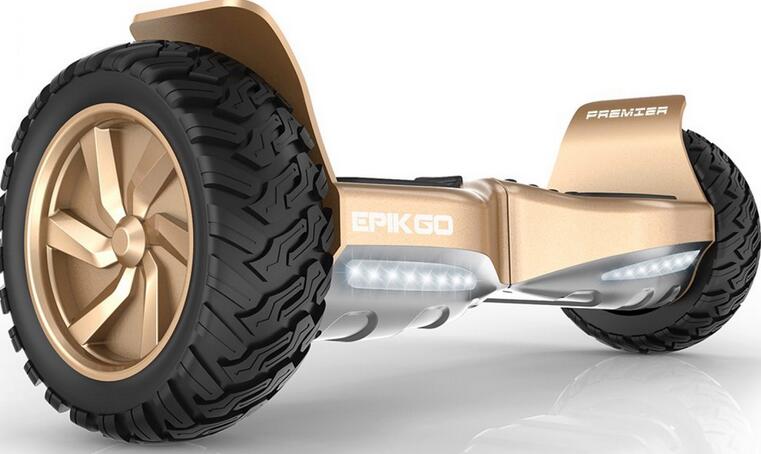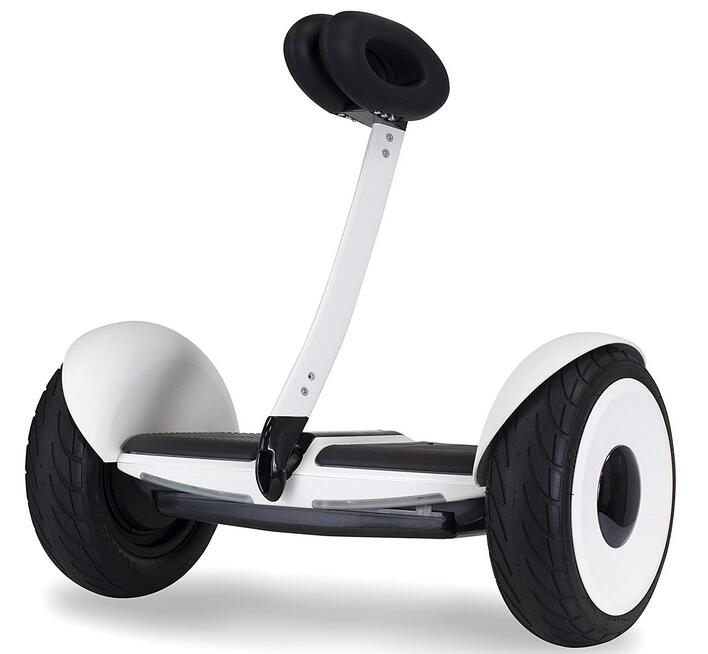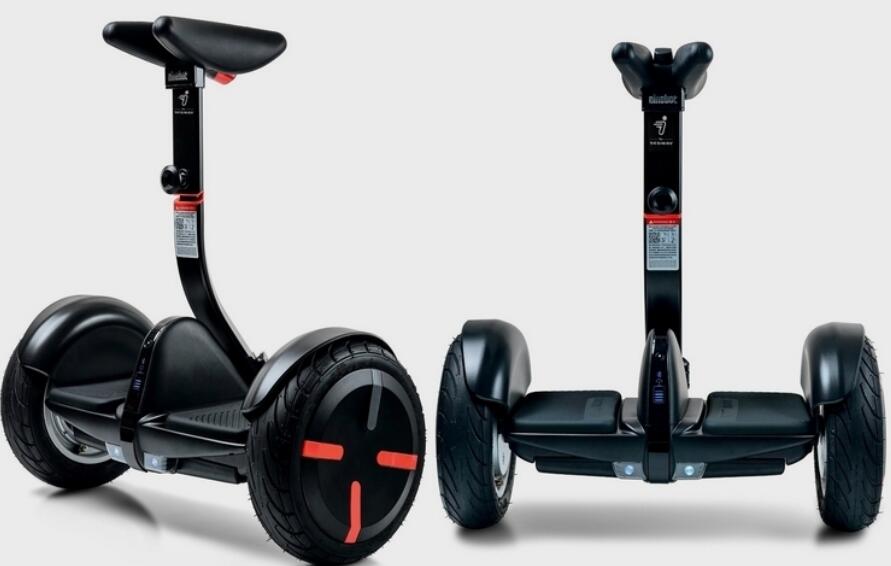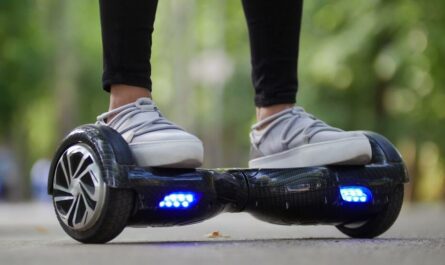In the world of personal transportation, two futuristic devices have taken the streets by storm: the hoverboard and the Segway. Both promise a unique way to glide across urban landscapes, but which one is right for you? In this comprehensive guide, we’ll dissect the key differences between Segways and hoverboards. If you’re considering adding some high-tech wheels to your commute or just looking for a fun gadget to cruise around on, this article is just for you.
Table of Contents
What Is a Hoverboard and How Does It Work?

A hoverboard, also known as a self-balancing scooter, is a two-wheeled, battery-powered device that’s controlled by the rider’s feet. The hoverboard has two wheels connected by a central platform on which the rider stands, and it uses gyroscopes and sensors to stay balanced. To move, the rider simply leans in the desired direction, and the electric motor responds accordingly.
Despite their name, hoverboards don’t actually hover but roll on the ground. Their compact size makes them highly maneuverable in tight spaces.
Hoverboards come with a variety of features and options. Some models have larger wheels and are designed for off-road use, while others prioritize portability and lightweight design for easy commuting.
They often come with different battery capacities, offering varying ranges and speeds. Additionally, hoverboards may include features like built-in Bluetooth speakers, LED lights, and smartphone app connectivity for a customizable riding experience.
Understanding the Segway: More Than Just a Brand

The Segway is often thought of as a brand, but it’s actually a specific type of personal transporter that features a handlebar for steering and a larger platform for standing. Segways typically come with larger wheels and weigh more, providing a sturdier ride.
Originally designed for commuting and more robust applications, Segways have evolved with models like the Segway Ninebot, which cater to a broader market and include a variety of features like app connectivity and anti-theft systems.
Segways offer a range of options to suit different needs and preferences. Some models prioritize off-road capabilities, with larger wheels and enhanced suspension systems for a smoother ride on uneven terrain.
Others focus on portability and compact design, making them ideal for urban environments. Segways often come with advanced features like smartphone app integration, customizable LED lights, and extended battery life for longer rides.
Segway vs Hoverboard: Unveiling the Key Differences
1. Comparing Design: Segways vs Hoverboards
When it comes to the overall design, the major difference between a Segway and a hoverboard is their size and the inclusion of a handlebar. Segways are generally larger, with a robust overall design that makes them ideal for longer commutes and off-road adventures.
The handlebar provides additional stability and control, allowing riders to navigate with ease. Hoverboards, on the other hand, are smaller and more lightweight, making them a fun choice for casual riding and easier to carry around.
Design Comparison Table
Here’s a comparison table highlighting the key design differences between Segways and hoverboards:
| Design Aspect | Segway | Hoverboard |
|---|---|---|
| Size | Larger | Smaller |
| Handlebar | Yes | No |
| Wheel Size | Larger | Smaller |
| Weight | Heavier | Lighter |
| Portability | Less portable | Highly portable |
2. Performance Battle: Speed, Battery Life, and Range
When it comes to performance, Segways and hoverboards have distinct characteristics that set them apart. Segways often offer higher top speeds compared to hoverboards, making them ideal for users who want to zip around quickly. Some Segway models can reach speeds of up to 12.5 mph, while hoverboards typically have a top speed ranging from 6 to 10 mph.
Battery life is an important consideration for any electric personal transporter. Segways, with their larger batteries, often provide longer miles on a single charge compared to hoverboards.
Depending on the model, Segways can offer a range of up to 25 miles before needing a recharge. Hoverboards, on the other hand, offer a range that varies depending on the battery capacity and usage. Most hoverboards can travel between 6 and 15 miles on a single charge.
One factor to consider is the type of terrain you’ll be riding on. Segways are designed to handle a variety of terrains, including off-road surfaces and uneven pavement. With larger wheels and enhanced suspension systems, they offer a smoother ride over bumps and rough terrain.
Hoverboards, although not as versatile on different terrains, can still handle flat surfaces and light inclines with ease. They are best suited for urban environments and smooth pathways.
Performance Comparison Table
Here’s a comparison table highlighting the performance differences between Segways and hoverboards:
| Performance Aspect | Segway | Hoverboard |
|---|---|---|
| Top Speed | Varies | Varies |
| Battery Life | Longer | Varies |
| Range | Longer | Varies |
| Terrain Adaptability | Versatile | Limited |
| Off-road Capabilities | Yes | Some models |
3. Variety of Features: Which Offers More?
Hoverboards and Segways come with a variety of features designed to enhance the riding experience. From Bluetooth speakers to custom lighting that helps you navigate in the dark, both types of transporters cater to tech-savvy users.
Segways might offer more sophisticated features like the Segway app, which allows you to track your ride in real-time, whereas hover-1 hoverboards, particularly the Ultra and Chrome models, focus on a user-friendly experience with elements like smoother ride technology.
Feature Comparison Table
Here’s a comparison table highlighting the variety of features offered by Segways and hoverboards:
| Feature Aspect | Segway | Hoverboard |
|---|---|---|
| Bluetooth Speakers | Yes | Some models |
| LED Lights | Yes | Some models |
| Smartphone App | Yes | Limited |
| Anti-Theft Systems | Yes | Some models |
| Smoother Ride Technology | No | Some models |
4. Safety First: Examining Safety Features in Segways and Hoverboards
Safety is a top priority when riding any personal transporter. Both Segways and hoverboards have implemented safety features to ensure rider stability and minimize the risk of accidents.
Modern hoverboards are equipped with gyroscopic technology and sensors that help maintain balance and stability. Some hoverboards even have built-in systems that prevent the rider from exceeding safe speeds or leaning too far forward or backward. These safety features help improve the overall riding experience and reduce the likelihood of falls or injuries.
Segways, with their handlebars and knee control bars, provide additional stability and control for riders. The handlebar allows users to steer and navigate with ease, while the knee control bar helps maintain balance. Segways also incorporate advanced safety features such as anti-theft systems, which can deter theft and provide peace of mind for riders.
It’s important to note that wearing protective gear, such as helmets, knee pads, and elbow pads, is strongly recommended when riding both Segways and hoverboards. These accessories can provide an extra layer of safety and protect against potential injuries in case of accidents or falls.
5. Ease of Use: Learning to Ride a Segway vs a Hoverboard
Learning to ride a Segway or a hoverboard may seem intimidating at first, but with practice and proper guidance, it can be a fun and rewarding experience.
Hoverboards require some initial balance and coordination skills to get the hang of riding. Most models have intuitive controls that respond to the rider’s movements. To move forward, the rider simply leans forward, and to stop or move backward, the rider leans backward. Balancing on a hoverboard can be challenging at first, but with practice, riders can quickly adapt and gain confidence.
Segways, with their handlebars and knee control bars, provide additional stability and support for riders. The handlebar allows users to steer and control the direction of the Segway, while the knee control bar assists in maintaining balance.
Learning to ride a Segway generally requires less effort and coordination compared to a hoverboard. The handlebar and knee control bar make it easier for riders to maintain stability and control.
Beginners need to take the time to familiarize themselves with the controls and practice in a safe and open area before venturing into more crowded or challenging environments. Start by getting comfortable with basic movements, such as forward and backward motion, turning, and stopping. Gradually increase the difficulty level as confidence and skills improve.
6. Portability: Size and Weight Compared
Portability is an important factor to consider when choosing between a Segway and a hoverboard, especially for users who need to carry their personal transporter frequently or navigate tight spaces.
Hoverboards are known for their lightweight and compact design, making them highly portable. Most hoverboards weigh between 20 and 30 pounds, making them easy to carry and transport. Their smaller size also allows for convenient storage in tight spaces, such as lockers or under desks.
Segways, on the other hand, tend to be heavier and bulkier due to their larger wheels and overall design. Depending on the model, a Segway can weigh anywhere from 40 to 100 pounds. While they may not be as portable as hoverboards, Segways often come with features like collapsible handlebars or removable components, which can make transportation and storage more manageable.
When it comes to portability, it’s essential to consider your specific needs and usage patterns. If you often find yourself carrying your personal transporter for short distances or need to navigate crowded areas, a lightweight hoverboard may be the more suitable option.
However, if you prioritize stability and comfort during longer rides or off-road adventures, a slightly heavier Segway might be worth the trade-off in portability.
7. Cost Considerations: Are Segways More Expensive than Hoverboards?
When it comes to price, Segways are generally more expensive than hoverboards due to their larger size, more substantial build, and additional features. However, there are great options available for both types of transporters, and the one that may be a better value depends on your circumstances and how you plan on using it.
8. Legal Aspects: Where Can You Legally Ride Them?
Before you decide between a Segway or a hoverboard, it’s essential to check with your local regulations. Some areas have restrictions on where you can ride these devices, and it’s important to be aware of the laws to avoid fines or confiscation.
Summary of Key Points to Remember
- Hoverboards are compact, two-wheeled devices that are great for fun and short commutes.
- Segways have a handlebar and are larger, providing a more robust ride suitable for longer distances and varied terrains.
- Performance varies, with Segways generally offering more speed and range.
- Features differ, with Segways boasting advanced options like app connectivity, while hoverboards focus on user-friendly design.
- Safety is paramount for both, with modern advancements in stability and accident prevention.
- Learning to ride either device comes down to personal preference and confidence.
- Portability favors hoverboards due to their lighter weight.
- Costs are higher for Segways, reflecting their larger build and feature set.
- Legal restrictions may apply, so always check your local laws regarding the use of personal transporters.
Conclusion
Choosing between a Segway and a hoverboard ultimately depends on your specific needs, preferences, and riding style. Both personal transporters offer unique benefits and features that cater to different users.
Hoverboards excel in their compact size, lightweight design, and maneuverability, making them ideal for short commutes, casual rides, and navigating urban environments. They are a popular choice for users looking for a fun and portable mode of transportation.
Segways, with their handlebars and larger wheels, provide a more robust and stable riding experience. They are well-suited for longer distances, off-road adventures, and riders who prioritize comfort and versatility. Segways often come with advanced features and customizable options, offering a more comprehensive and personalized riding experience.
Related posts:
 How Much Do Hoverboards Cost? 2024 Prices and Guide
How Much Do Hoverboards Cost? 2024 Prices and Guide  How Long Does a Hoverboard Battery Last? Maximizing Your Ride
How Long Does a Hoverboard Battery Last? Maximizing Your Ride  How Much Does Hoverboards Weigh? A Complete Guide
How Much Does Hoverboards Weigh? A Complete Guide  Can You Ride a Hoverboard in the Rain?Tips for Safe Riding
Can You Ride a Hoverboard in the Rain?Tips for Safe Riding  When Did Hoverboards Come Out? History of Origins
When Did Hoverboards Come Out? History of Origins  How Do I Know if My Hoverboard is Charging?
How Do I Know if My Hoverboard is Charging?



